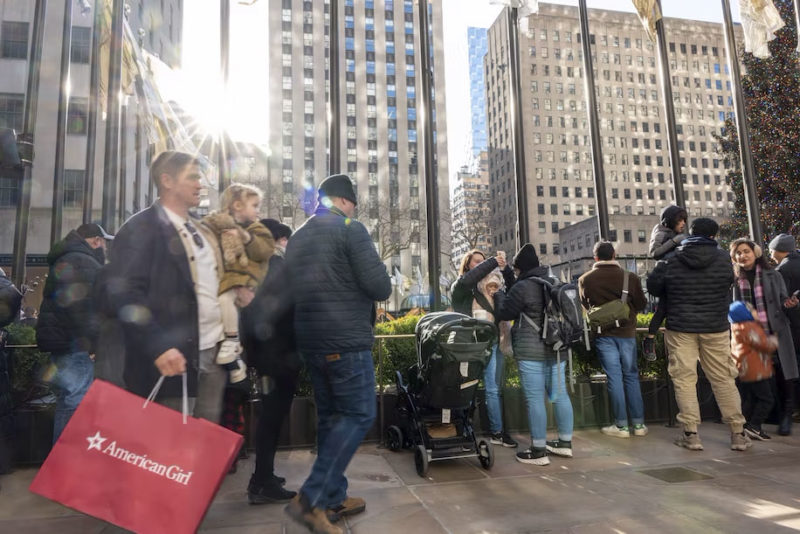With a strong economy, the first rate cut may not come soon
As the Rockettes high-kicked their way to a record box office for the annual “Christmas Spectacular” at New York’s Radio City Music Hall, they were doing more than just entertaining.
They were also showing the limits of the Federal Reserve’s power over the economy.
If the Fed’s interest rate increases had worked after the pandemic the way they had in the past, Americans would have responded by cutting their spending. Instead, the economy has powered ahead almost unscathed.
Demand was so high for Rockettes tickets that the dance troupe added eight extra shows to its schedule, extending the Christmas specials into the first week of January. More than 1 million customers saw the holiday performances.
Elsewhere, companies such as Hilton, Ford and Chipotle benefited from consumers and businesses opening their wallets. Despite the fastest interest rate increases in four decades, the economy is hotter today than when the Fed first lifted borrowing costs in March 2022. The 353,000 jobs created last month were the highest monthly total since January 2023.
“Even though the Fed is hiking, people aren’t feeling it,” said Nathan Sheets, global chief economist for Citigroup.
The strong growth has calmed recession fears and may cause the Fed to delay its much-anticipated move to begin rate cuts.
When the Fed fights inflation, it typically raises interest rates to discourage consumers and businesses from borrowing money. Fewer personal and business loans translate into lower demand for all sorts of goods, slowing the economy and taking the pressure off prices.
That was the idea when the Fed started raising rates two years ago as U.S. inflation approached levels unseen since the early 1980s. From near zero, the Fed’s benchmark lending rate jumped to its current level above 5 percent in less than 18 months.
But the results were unexpected.
Rising interest rates usually lift the value of the dollar, which widens the trade deficit, since foreign products become more affordable while U.S. exports suffer, according to economist Dean Baker of the Center for Economic and Policy Research.
This time, however, many other central banks were raising their interest rates to battle inflation. So the dollar did not have a sustained rise. And the trade deficit grew smaller rather than larger, as consumers stopped buying imports and began spending more on in-person services, such as movies and dining out.
The last time the Fed engaged in significant rate increases, starting in the spring of 2004, the economy slowed from growing around 3 percent to expanding by less than 1 percent two years later.
Today’s economy has been able to shrug off higher rates, in part because of the extraordinary period of rock-bottom borrowing costs that followed the 2008 financial crisis.
Adjusted for inflation, credit was effectively free most of the time between 2008 and 2022. That easy-money era enabled many consumers and businesses to refinance their debts and lock in ultralow rates, according to Sheets.
In the latest wave of home mortgage refinancing, 14 million Americans “benefitted from historically low interest rates and will be enjoying low financing costs for decades to come,” the Federal Reserve Bank of New York said last year.
As a percentage of disposable income, debt service payments are no larger than they were when the Fed began raising rates and are still slightly lower than on the eve of the pandemic.
Many consumers and businesses today are less sensitive to higher rates than in the past, thanks in part to the pandemic’s legacy.
For much of the past few years, millions of consumers have had more cash than usual. Trapped at home and supported by government stimulus programs, Americans stockpiled money. Excess liquid assets peaked in early 2022 at an estimated $1.5 trillion, according to Eric Winograd, director of developed market economic research for AllianceBernstein.
The congested supply chains that were a major headache during the pandemic also had a silver lining: Spending on products such as automobiles was stretched out over a longer period, economists said.
Americans who could not find a car to buy in 2021 or 2022 eventually did so. And by the time there were cars on dealer lots, many shoppers were willing to pay higher prices. December’s vehicle sales hit an annual rate of 16.6 million, compared with a 14 million pace two years earlier.
“The economy has outperformed the most optimistic expectations despite this tightening cycle,” Winograd said. “But almost all of that excess savings has been worked through. That cushion isn’t there anymore.”
As those temporary factors wear off, higher rates may finally start to bite. Higher rates are leading some businesses to “reassess future projects and were contributing to softer business investment and hiring,” according to the minutes of the Fed’s December meeting. Small businesses encountered tighter credit.
The percentage of auto loans that became overdue by 90 days just moved above its pre-pandemic level. Delinquent credit card balances also are higher than in 2019, according to the New York Fed.
This complex portrait of an economy growing fast in defiance of rising rates, yet showing signs of strain, puts pressure on the Fed to get the timing right for its first rate cut, expected as soon as May.
Fed Chair Jerome H. Powell said at the end of January that higher rates are having an effect on the economy, notably via the housing market. The Fed’s rate hikes reduce demand by making credit more expensive. Indeed, sales of new homes dipped over the second half of last year as 30-year mortgage rates approached 8 percent.
But Powell acknowledged that other factors beyond the Fed’s control — such as improved supply chain performance and the return of more Americans to the labor force — also are reducing inflation.
They also are effectively shielding parts of the economy from the full force of tighter credit. But as companies iron out the final kinks in their freight operations and the pool of available labor stops growing, those supply-side gains will fade and the rate hikes will take a greater toll.
“The restriction will show up probably more sharply,” Powell said.
In housing construction, which tends to be more sensitive to interest rate hikes,supply chain snarls also effectively stretched out some activity, helping buttress the economy, Baker said.
New housing starts have fallen almost 20 percent from their April 2022 level of 1.8 million. But the number of homes under construction, which usually declines alongside starts, has held steady at about 1.7 million. Homes have been taking longer to build because of delays in obtaining needed materials, Baker said.
The good news is that, as a result of those snags, residential construction employment remains at its highest level since September 2007.
That may be starting to change.
Home builder PulteGroup by the end of this year expects to be building new homes about as quickly as before the pandemic. The company told analysts last week that its operations were returning to a “predictable schedule,” thanks to more reliable deliveries of construction supplies.
“We were just literally waiting for material to show up,” said Ryan Marshall, chief executive of PulteGroup.
Many economists had expected the unemployment rate to rise before inflation was brought under control. In June 2022, Lawrence Summers, a former treasury secretary, said the jobless rate would need to hit 6 percent and stay there for five years before consumer prices calmed.
Instead, the unemployment rate barely budged: It was 3.6 percent when the Fed began raising rates, and it is 3.7 percent today. In each of the last three months, the number of Americans finding new jobs has been higher than in the previous month.
The job market has been supported by the gradual return of consumer spending to its pre-pandemic pattern. After splurging on products such as furniture, televisions and clothing, consumers now are devoting more money to travel, entertainment and other personal experiences.
Hilton Hotels served a record number of guests last year and added 24,000 new rooms in the final three months of 2023, its largest quarterly total ever. The lodging chain’s revenue-per-available-room, a standard industry benchmark, increased by almost 13 percent.
“The demand is really strong,” Christopher J. Nassetta, CEO of Hilton Worldwide, told investors last week. “The consumer, particularly our consumer, which is our median income levels, reasonably good, it’s in the $140,000 to $150,000 range, they still have plenty of money, plenty of desire to travel.”
Such spending on travel, leisure and hospitality is roughly three times as labor intensive as goods-producing industries, according to Sheets. Chipotle Mexican Grill, for example, plans to hire 19,000 new workers for its busy spring season. JPMorgan Chase likewise said it had 3,500 openings to staff a planned expansion of its retail branch network.
Spending on in-person services is keeping the labor market tight, which means higher wages. Inflation-adjusted hourly earnings for production and nonsupervisory employees rose by 1 percent over the past year, according to the Labor Department. Those fatter paychecks mean Americans have the disposable income to continue spending on trips to New York.
Madison Square Garden Entertainment, the Rockettes’ owner, told investors it plans to capitalize on strong demand by increasing ticket prices for their next Christmas performance. Tickets for the 2023 show started at $49.
MSG also reported a “strong double-digit increase” in the number of tickets sold for the musical concerts it will stage over the next six months.
Scheduled to appear at the Garden are entertainers such as Billy Joel, Nicki Minaj and Justin Timberlake. Tickets for these performances start at around $200 and can exceed $4,800 for floor seats, according to the MSG website.
“We’re really pleased with how this year is unfolding,” said Ari Danes, senior vice president for investor relations. “The business is clearly growing at a faster clip than we had initially anticipated.”
Source: washingtonpost.com













